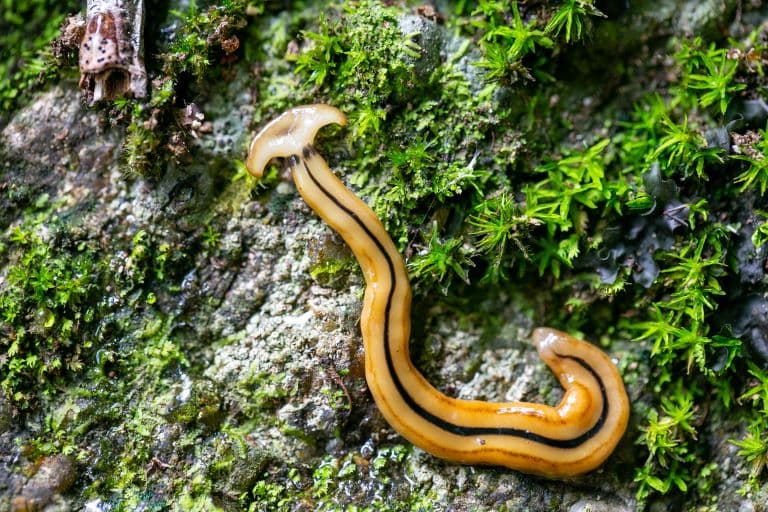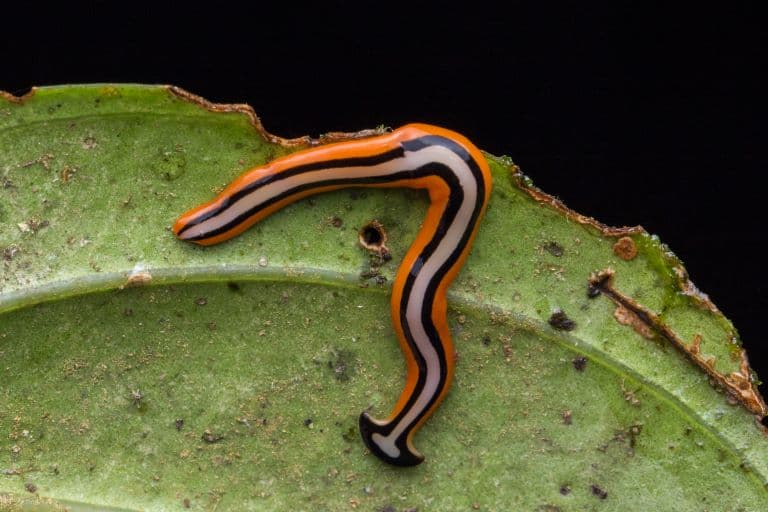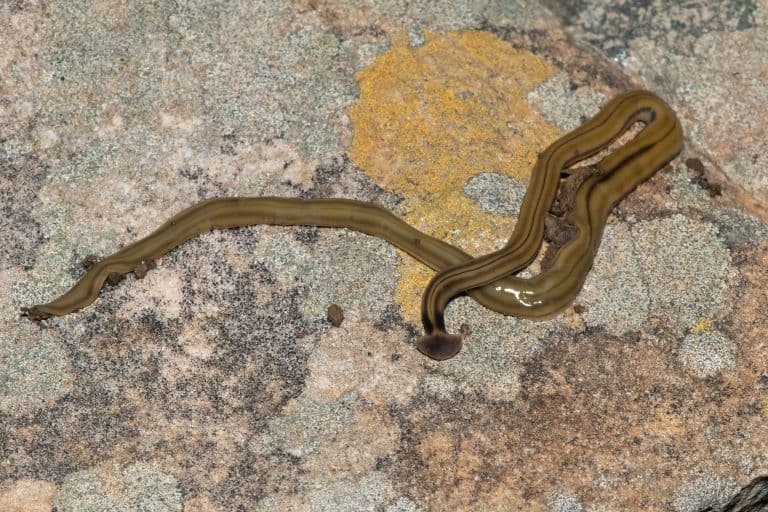Hammerhead Worm Profile
We typically think of worms as the helpful little fellas that build our compost and aerate the ground for our plants. They’re harmless, docile, and, while a bit gooey, generally considered a good thing to have around.
But even within the earthworm phylum, there’s incredible diversity. Marine worms with golden hair, worms inside tubes, and worms with feather-like tentacles that they can see with. Then, there are other phyla of worms.
Flatworms, for example, some of which are found on land, and unlike their detritus-eating namesakes, some are prone to chasing down and killing our compost bros with a toxic bite.
Hammerhead worms, or “landchovies” are native to Asia, but are spreading worryingly around the world.

Hammerhead Worm Facts Overview
| Habitat: | Terrestrial, damp areas with rooted plants |
| Location: | Native to Asia, introduced to Europe, North America |
| Lifespan: | Possibly forever |
| Size: | Up to 40cm (16 in) long in some species, usually much smaller |
| Weight: | Not recorded |
| Colour: | Varied, usually browns, oranges and greens |
| Diet: | Molluscs, worms, other soft-bodied invertebrates |
| Predators: | No known predators |
| Top Speed: | Slow |
| No. of Species: | 200+ |
| Conservation Status: | Not Listed |
Hammerhead worms are alarming even if you’re not on the menu.
They’re named for their hammer-shaped head, which is used to find and incapacitate prey, and they secrete one of the most dangerous toxins in the animal kingdom to help.
Being this poisonous, they have few to no predators and now that they’re invading Europe and the Americas, they have the potential to cause significant damage to our detritus feeders.
Oh, and don’t try cutting them up – the pieces will just turn into more worms, which can live on indefinitely.
Interesting Hammerhead Worm Facts
1. They’re Planarians
While they sound like an industrious alien faction, the Planarians are very much a real group of worms.
They’re Platyhelminths, members of an entirely different phylum of worm than the earthworms, and flatter. And as such, they’re commonly called flatworms.
While flatworms come in many shapes and sizes depending on the species – most of which are found in water – one family, the Geoplanid worms, are known for living exclusively on land.
And this is a family of predators. One genus within this family has a distinctive hammerhead attachment, which is used to great effect while hunting.
Another name for the hammerhead worms specifically is the landchovy, on account of it being a foul-tasting, slimy, brown piece of brown flesh that has no business on a pizza.

2. They’re predatory
As we mentioned, this entire family is predatory, but the hammerhead genus is particularly frightening if you’re a worm or slug that happens to be living within their hunting range.
These worms track their chosen prey using their paddle-shaped heads, and once caught, brutally kill and devour them. There are a few adaptations to make this easier, all very unsettling. 1
3. They can throw their pharynx
This isn’t the same mechanic as a ventriloquist throwing a voice, this is a physical ejection or eversion of the pharynx.
This is a predatory strategy that could have come right out of a John Carpenter or Ridley Scott movie but is entirely non-fictional.
Before they reach this stage though, the hammerhead worms catch up and adhere to their victim using special sticky secretions.
These secretions also contain various other substances you don’t want on your skin, and the worm itself is muscular and powerful enough to overpower a struggling earthworm and hold it in place while it unfurls its innards to spew digestive juices all over the poor thing.
This means that the worm begins getting digested while still alive, and before being swallowed, and this process comes from at least one collagen-destroying enzyme called collagenase. But there are other dodgy chemicals involved here, too.
4. They carry puffer fish toxins
While the collagenase helps dissolve the earthworm’s tissues, the flathead also has a potent neurotoxin more commonly associated with the pufferfish: tetrodotoxin is the reason some people drop dead from eating these fish when they’re not prepared properly, and it’s also found in the hammerhead worm, probably as a way of subduing a struggling victim faster.
This is also why they aren’t fun for most other animals to eat, and why it’s so hard to find any natural predators of the hammerhead. 2

5. They’re efficient
These adaptations make them very effective hunters, but there’s even more to their physiology that’s weird.
Since they breathe through their skin, they have no respiratory system. They don’t have a circulatory system either, since dissolved gasses just permeate in and out as needed.
Instead of an input and an output, these worms just have one digestive bag, into which everything comes and goes. So, no need for an anus!
They will also eat one another if they meet, which saves time chasing down earthworms. 3
6. They’re invasive
And this highly efficient predator is causing a lot of trouble in ecosystems that didn’t evolve to look out for it. While they’re native to Asia, they have been introduced to the Americas and Europe, and are now listed as invasive in several locations.
With few to no predators, they will be more or less unchecked, and with the ability to reproduce outside of the presence of any other worm, this is a bit worrying. 4

7. They can reproduce when cut in half
It’s often said that earthworms who were unlucky enough to be bifurcated by a garden spade will heal up and go off on their way as two new worms.
This, unfortunately, isn’t the case, and while one half might survive being cut in two if it contains all the vital organs, it’s more likely that both ends will be dead within a few hours.
Not so with the hammerhead worm, though. So, chopping away at them can only make things worse. In fact, one of their commonest methods of reproduction occurs this way.
Many species are known to reproduce asexually, by a process called fission, which involves breaking off a piece of themselves and carrying on as if nothing ever happened. These offcuts will develop into new worms – albeit with no sexual organs – and they, too, will eventually start splitting up into more worms still.
So, they have the potential to reproduce in terrifying and rapid ways. Luckily, they can’t retain moisture on account of being so porous, so they’re limited physically to very humid areas, but this isn’t much of a consolation to the soft-bodied fauna who also live there.
All of this means that there’s no true way to pin a longevity metric to these worms. It appears that they can keep doing this indefinitely, making them more or less immortal.
Hammerhead Worm Fact-File Summary
Scientific Classification
| Kingdom: | Animalia |
| Phylum: | Platyhelminths |
| Class/clade | Turbellaria |
| Order: | Tricladida |
| Family: | Geoplanidae |
| Genus: | Bipalium |
Fact Sources & References
- Daniel L. Dindal (1970), “Feeding Behavior of a Terrestrial Turbellarian Bipalium adventitium”, JSTOR.
- (2023), “Toxic hammerhead worms; expert provides advice for dealing with the invasive species at home”, Virginia Tech.
- (2021), “Awesome Animal – Hammerhead Worm”, Stan C. Smith.
- “Hammerhead Worm”, National Invasive Species Information Center.
